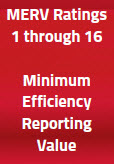OVERVIEW
The purpose of a filter in a welding fume extraction system is to trap and hold airborne particulates so they do not contaminate the air. Filters incorporate a filter medium (fiberglass, cellulose, or polyester fibers) made from microscopic fibers woven in sheets and pleated in a “V” pattern. The pleating of the material increases the surface area of the filter providing an increased capture surface. This white paper discusses the six important factors about filter replacement for a welding fume extraction system.
1. What are the types of filters and what do I need to know about each?
- Pre-filter – The purpose of a pre-filter is to capture larger particulates and remove them from the system so they do not reach the paper filter. The pre-filter is typically made from aluminum or steel mesh and acts as a spark arrestor.
- Main filter – The main filter is designed to capture the majority of the particulates from the welding, cutting and grinding processes.
- After filter – The purpose of the after filter is to filter out the remainder of very small particulates. This is similar to the high-efficiency particulate absorption (HEPA) filter on a vacuum cleaner. It is typically designed for very small particulates (0.1 to 0.3 microns).
- A HEPA filter is also known as a High Efficiency Particulate Air filter that allows for filtration efficiency up to 99.9% depending on particulate size.
2. When should I replace the filter?
There are a number of factors that go into predicting when to replace your filter. Knowing how much particulate is going into the filters, how many hours and shifts you work, the type of welding processes and materials in use are among the factors that can affect this answer. Indicators signaling filter replacement vary depending on the type or model of fume extraction system. Here are some common indicators:
- An indicator light on the fume system control panel will blink or change from white to red, indicating the current filter cartridge is full. Once the filter is saturated with particulate it is time to replace the filter.
- The filter cleaning system will be unable to obtain a pressure below 1500 Pa. After 5 attempts, replace the filter cartridge. If the system is equipped with an audible reminder, a filter replacement audible tone will activate.
- After several cleaning cycles, the suction performance of the system remains less than normal. In these cases, the filter should be replaced to restore optimal performance. The necessity for preventive maintenance, cleaning and filter replacement is critical to the performance of your weld fume extraction system.
3. What filter type should you use?
The welding and material used dictates what type of filter media is required for your system. A variety of filter types, based on a MERV rating, are available to address different welding processes and applications.
For example, if you have a stainless steel welding application, a higher rated filter will generally be required because of the low OSHA PEL for chromium. If you use a standard mild steel MIG process, a lower rated filter can be sufficient. Once you have selected a filter, always check to be certain it is controlling worker exposure to constituents in the fume by having a qualified person measure worker exposure.
A filter should be selected based on the volume, frequency and type of welding performed. For example, welding with the gas metal arc welding (GMAW) process produces far less fume than a flux-cored arc welding (FCAW) or shielded metal arc welding (SMAW) process, meaning a filter used with the GMAW process will have a longer life. Welding electrode manufacturers typically publish weld fume generation rates, allowing you to match filter capability to the intended electrode’s fume generation rate. The American Welding Society (AWS) also publishes some typical data regarding electrode.


 Download White Paper
Download White Paper